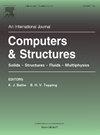An efficient analytical method for broadband vibro-acoustic analysis of coupled beam-cavity systems
IF 4.4
2区 工程技术
Q1 COMPUTER SCIENCE, INTERDISCIPLINARY APPLICATIONS
引用次数: 0
Abstract
This paper presents an analytical approach that integrates the dynamic stiffness method (DSM) with the spectral dynamic stiffness method (SDSM) for broadband vibro-acoustic modelling of coupled beam-cavity systems. This combined method uses frequency-dependent shape functions to describe both the structural and the acoustic domains, while the interaction between them is analytically modelled by using the modified Fourier series (MFS). In particular, the DSM uses the particular solutions of beams expanded by the MFS to express analytically acoustic pressure loadings of cavities, eliminating extra fine domain discretizations; the SDSM, on the other hand, formulates the coupling conditions using the MFS in a strong sense by direct enforcement of velocity continuity conditions at the coupling boundaries, enabling more accurate boundary condition handling and physically meaningful solutions. Finally, based on the system matrix equation with very few degrees of freedom, the efficient Wittrick–Williams algorithm is extended to extract eigenvalues of the coupled systems while vibro-acoustic responses are evaluated with high accuracy. The proposed method, validated against benchmark and practical problems, achieves up to 18 times faster computation than COMSOL while maintaining comparable accuracy. This promising method can provide an efficient tool for vibration and noise prediction during early design phases.
耦合梁腔系统宽带振声分析的一种有效分析方法
本文提出了一种将动力刚度法与谱动力刚度法相结合的分析方法,用于耦合梁腔系统的宽带振声建模。该组合方法使用频率相关的形状函数来描述结构域和声学域,而它们之间的相互作用则使用改进的傅立叶级数(MFS)进行分析建模。特别是,DSM使用由MFS展开的梁的特解来解析表达腔体的声压载荷,消除了额外的精细域离散化;另一方面,SDSM通过在耦合边界上直接执行速度连续性条件,在很大程度上使用MFS来制定耦合条件,从而实现更精确的边界条件处理和物理上有意义的解。最后,基于极少自由度的系统矩阵方程,将有效的Wittrick-Williams算法扩展到提取耦合系统的特征值,同时高精度地评估了系统的振声响应。通过对基准和实际问题的验证,该方法的计算速度比COMSOL快18倍,同时保持了相当的精度。该方法可以为设计初期的振动和噪声预测提供有效的工具。
本文章由计算机程序翻译,如有差异,请以英文原文为准。
求助全文
约1分钟内获得全文
求助全文
来源期刊

Computers & Structures
工程技术-工程:土木
CiteScore
8.80
自引率
6.40%
发文量
122
审稿时长
33 days
期刊介绍:
Computers & Structures publishes advances in the development and use of computational methods for the solution of problems in engineering and the sciences. The range of appropriate contributions is wide, and includes papers on establishing appropriate mathematical models and their numerical solution in all areas of mechanics. The journal also includes articles that present a substantial review of a field in the topics of the journal.
 求助内容:
求助内容: 应助结果提醒方式:
应助结果提醒方式:


